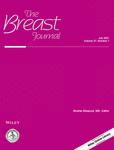Outcome of African-American compared to White-American patients with early-stage breast cancer, stratified by phenotype
Abstract
Background
Breast cancer mortality rates are 39% higher in the African-American (AA) women compared to White-American (WA) women despite the advances in overall breast cancer screening and treatments. Several studies have undertaken to identify the factors leading to this disparity in United States with possible effects of lower socioeconomic status and underlying aggressive biology.
Methods
A retrospective analysis was done using a prospectively maintained database of a metropolitan health system. Patients were selected based on diagnosis of early-stage breast cancer between 10/1998 and 02/2017, and included women over age of 18 with clinically node-negative disease. Patients were then stratified by phenotype confirmed by pathology and patient-identified race.
Results
A total of 2,298 women were identified in the cohort with 39% AA and 61% WA women. The overall mean age at the time of diagnosis for AA women was slightly younger at 60 years compared to 62 years for WA women (p = 0.003). Follow-up time was longer for the WA women at 95 months vs. 86 months in AA women. The overall 5-year survival was analyzed for the entire cohort, with the lowest survival occurring in patients with triple-negative breast cancer (TNBC). Phenotype distribution revealed a higher incidence of TNBC in AA women compared to WA women (AA 16% vs. WA 10%; p < 0.0001). AA women also had higher incidence of HER2 positive cancers (AA 16.8% vs. WA 15.3%; p < 0.0001). WA women had a significantly higher distribution of Non-TNBC/HER2-negative phenotype (AA 55% vs. WA 65%; p < 0.0001). Furthermore, a subgroup analysis was done for a sentinel lymph node (SLN) negative cohort that showed higher rates of grade 3 tumors in AA (AA 35% vs. WA 23%; p < 0.0001); and higher rates of grade 1 and grade 2 tumors in WA (30% vs. 21% and 44% vs. 40%). Despite higher grade tumors in AA women, five-year overall survival outcomes in SLN-negative cohort did not differ between AA and WA women when stratifying based on tumor subtype.
Conclusion
Breast cancer survival disparities in AA and WA women with SLN-negative breast cancer are diminished when evaluated at early-stage cancers defined by SLN-negative tumors. Our evaluation suggests that when diagnosed early, phenotype does not contribute to racial survival outcomes. The lower survival rate in AA women with breast cancer may be attributed to later stage biology between the two races, or underlying socioeconomic disparities.
CONFLICT OF INTEREST
The authors have no affiliations with or involvement in any organization or entity with any financial interest in the subject matter or materials discussed in this manuscript.
Open Research
DATA AVAILABILITY STATEMENT
The data that support the findings of this study are available from the corresponding author upon reasonable request.




